Self-Reflection Report: Dynamic Leadership, MGT601, Semester 2
VerifiedAdded on 2023/06/03
|10
|2845
|138
Report
AI Summary
This report is a self-reflection on dynamic leadership, detailing the author's leadership journey, current role, and insights gained through self-assessment tools and feedback. The author, currently a team leader in a real estate firm, analyzes their leadership style, highlighting strengths such as responsibility, achiever, and adaptability, as revealed by Gallup's StrengthsFinder. The report also addresses weaknesses, such as a lack of assertiveness and the tendency to apply pressure, and outlines areas for improvement. The author reflects on their experiences as a prefect, sports captain, and in their current corporate role, emphasizing the importance of communication, responsibility, and democratic leadership. The report concludes with a summary of the author's key learnings and plans for future leadership development, including strategies to balance assertiveness and reduce pressure on team members.
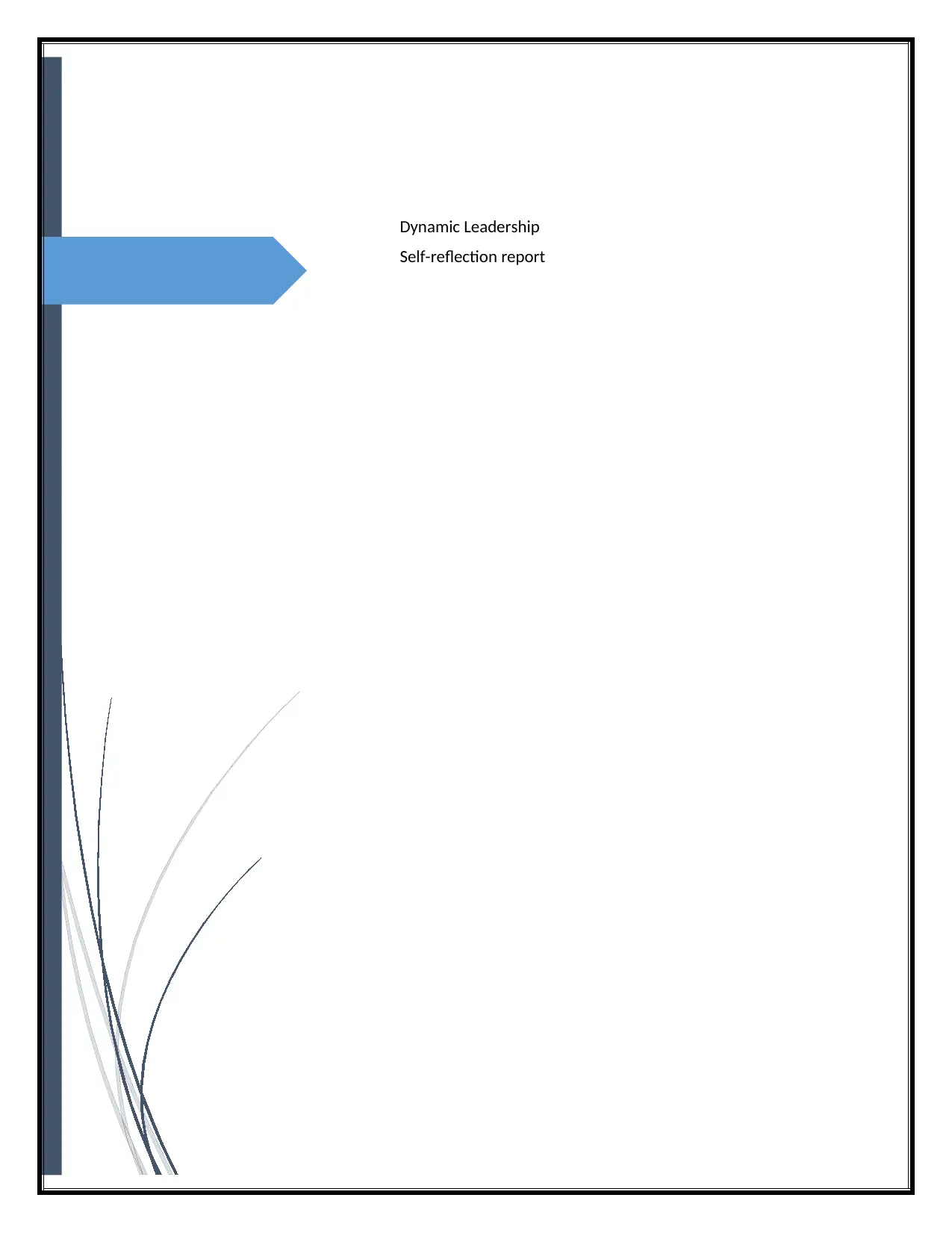
Dynamic Leadership
Self-reflection report
Self-reflection report
Paraphrase This Document
Need a fresh take? Get an instant paraphrase of this document with our AI Paraphraser
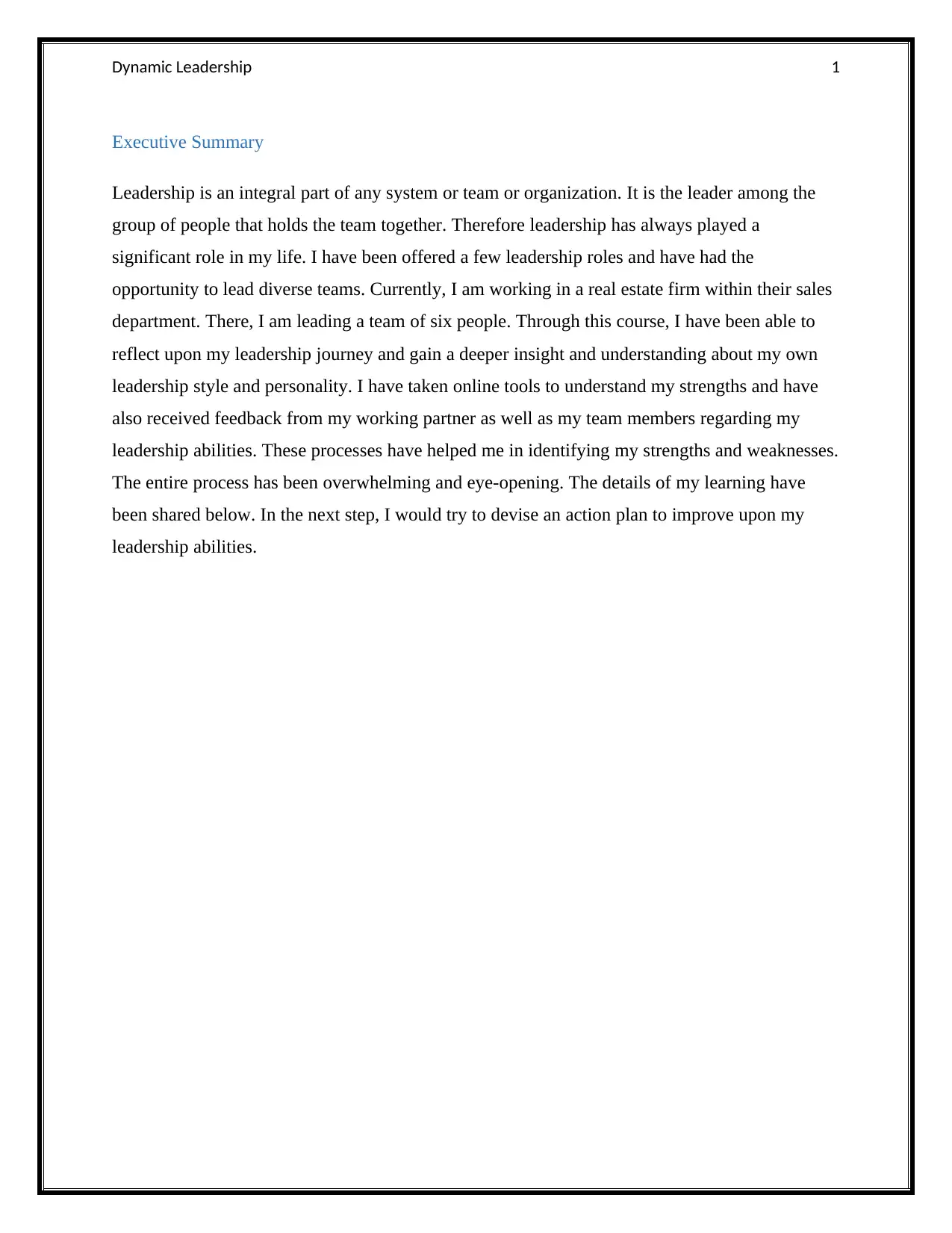
Dynamic Leadership 1
Executive Summary
Leadership is an integral part of any system or team or organization. It is the leader among the
group of people that holds the team together. Therefore leadership has always played a
significant role in my life. I have been offered a few leadership roles and have had the
opportunity to lead diverse teams. Currently, I am working in a real estate firm within their sales
department. There, I am leading a team of six people. Through this course, I have been able to
reflect upon my leadership journey and gain a deeper insight and understanding about my own
leadership style and personality. I have taken online tools to understand my strengths and have
also received feedback from my working partner as well as my team members regarding my
leadership abilities. These processes have helped me in identifying my strengths and weaknesses.
The entire process has been overwhelming and eye-opening. The details of my learning have
been shared below. In the next step, I would try to devise an action plan to improve upon my
leadership abilities.
Executive Summary
Leadership is an integral part of any system or team or organization. It is the leader among the
group of people that holds the team together. Therefore leadership has always played a
significant role in my life. I have been offered a few leadership roles and have had the
opportunity to lead diverse teams. Currently, I am working in a real estate firm within their sales
department. There, I am leading a team of six people. Through this course, I have been able to
reflect upon my leadership journey and gain a deeper insight and understanding about my own
leadership style and personality. I have taken online tools to understand my strengths and have
also received feedback from my working partner as well as my team members regarding my
leadership abilities. These processes have helped me in identifying my strengths and weaknesses.
The entire process has been overwhelming and eye-opening. The details of my learning have
been shared below. In the next step, I would try to devise an action plan to improve upon my
leadership abilities.
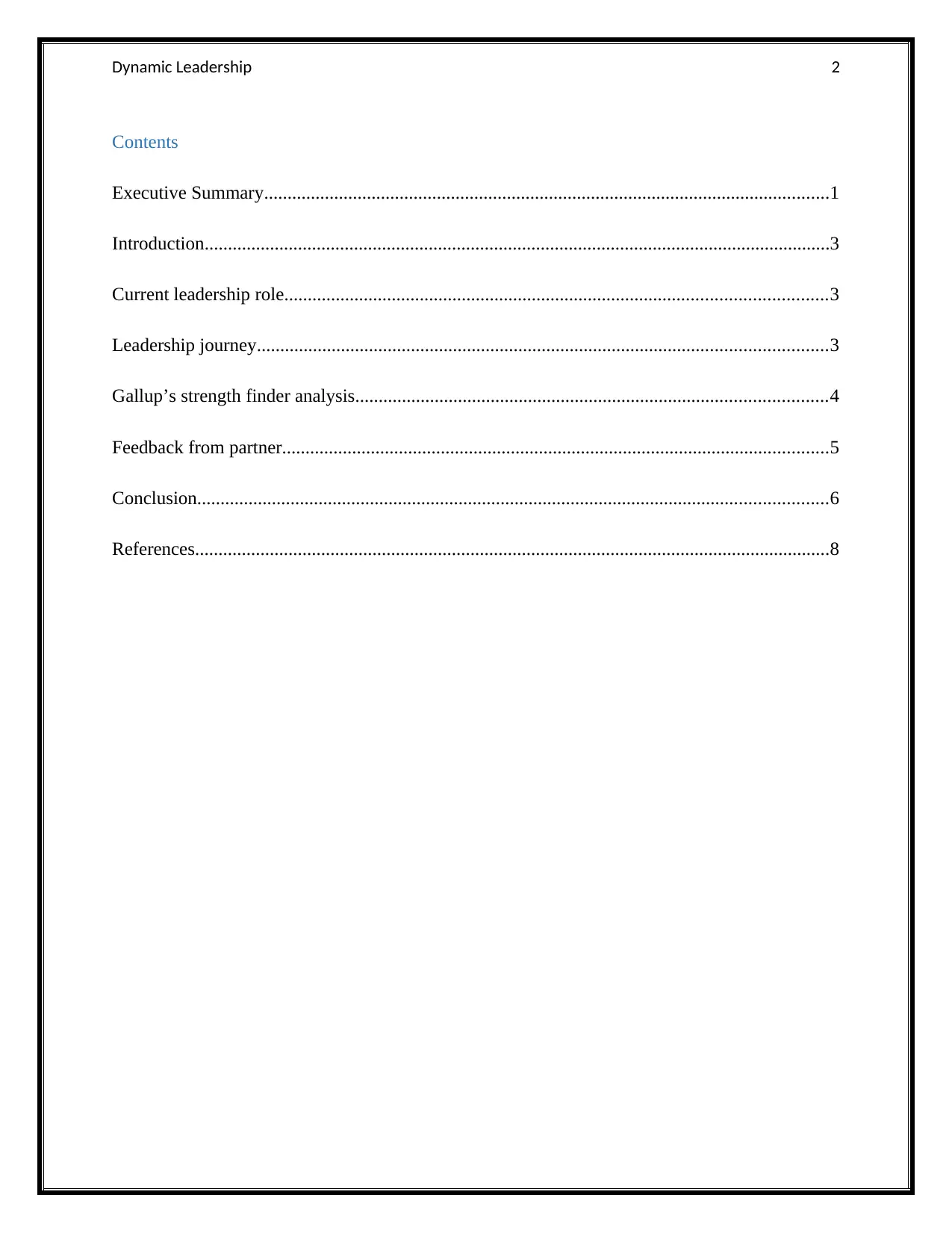
Dynamic Leadership 2
Contents
Executive Summary.........................................................................................................................1
Introduction......................................................................................................................................3
Current leadership role....................................................................................................................3
Leadership journey..........................................................................................................................3
Gallup’s strength finder analysis.....................................................................................................4
Feedback from partner.....................................................................................................................5
Conclusion.......................................................................................................................................6
References........................................................................................................................................8
Contents
Executive Summary.........................................................................................................................1
Introduction......................................................................................................................................3
Current leadership role....................................................................................................................3
Leadership journey..........................................................................................................................3
Gallup’s strength finder analysis.....................................................................................................4
Feedback from partner.....................................................................................................................5
Conclusion.......................................................................................................................................6
References........................................................................................................................................8
⊘ This is a preview!⊘
Do you want full access?
Subscribe today to unlock all pages.

Trusted by 1+ million students worldwide
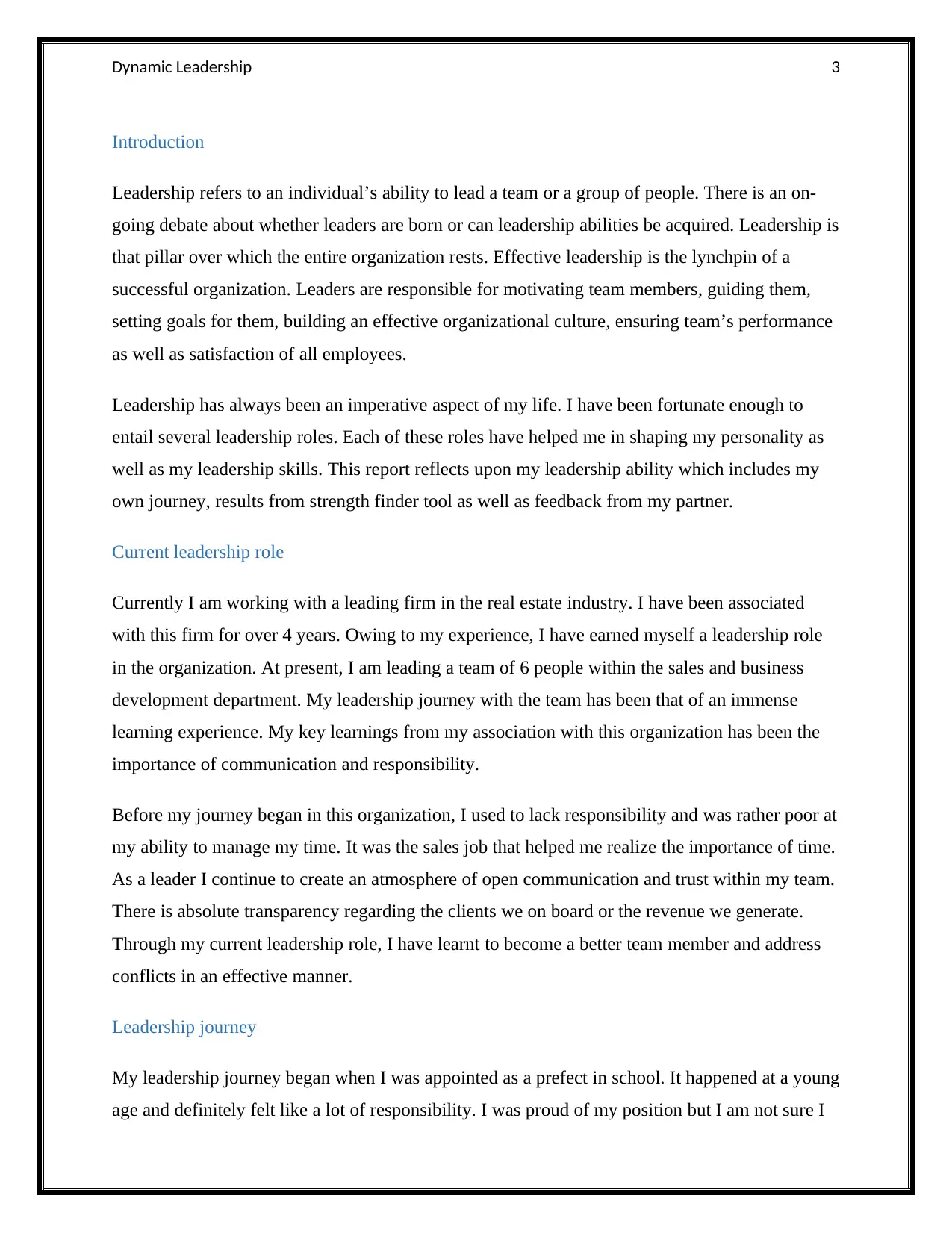
Dynamic Leadership 3
Introduction
Leadership refers to an individual’s ability to lead a team or a group of people. There is an on-
going debate about whether leaders are born or can leadership abilities be acquired. Leadership is
that pillar over which the entire organization rests. Effective leadership is the lynchpin of a
successful organization. Leaders are responsible for motivating team members, guiding them,
setting goals for them, building an effective organizational culture, ensuring team’s performance
as well as satisfaction of all employees.
Leadership has always been an imperative aspect of my life. I have been fortunate enough to
entail several leadership roles. Each of these roles have helped me in shaping my personality as
well as my leadership skills. This report reflects upon my leadership ability which includes my
own journey, results from strength finder tool as well as feedback from my partner.
Current leadership role
Currently I am working with a leading firm in the real estate industry. I have been associated
with this firm for over 4 years. Owing to my experience, I have earned myself a leadership role
in the organization. At present, I am leading a team of 6 people within the sales and business
development department. My leadership journey with the team has been that of an immense
learning experience. My key learnings from my association with this organization has been the
importance of communication and responsibility.
Before my journey began in this organization, I used to lack responsibility and was rather poor at
my ability to manage my time. It was the sales job that helped me realize the importance of time.
As a leader I continue to create an atmosphere of open communication and trust within my team.
There is absolute transparency regarding the clients we on board or the revenue we generate.
Through my current leadership role, I have learnt to become a better team member and address
conflicts in an effective manner.
Leadership journey
My leadership journey began when I was appointed as a prefect in school. It happened at a young
age and definitely felt like a lot of responsibility. I was proud of my position but I am not sure I
Introduction
Leadership refers to an individual’s ability to lead a team or a group of people. There is an on-
going debate about whether leaders are born or can leadership abilities be acquired. Leadership is
that pillar over which the entire organization rests. Effective leadership is the lynchpin of a
successful organization. Leaders are responsible for motivating team members, guiding them,
setting goals for them, building an effective organizational culture, ensuring team’s performance
as well as satisfaction of all employees.
Leadership has always been an imperative aspect of my life. I have been fortunate enough to
entail several leadership roles. Each of these roles have helped me in shaping my personality as
well as my leadership skills. This report reflects upon my leadership ability which includes my
own journey, results from strength finder tool as well as feedback from my partner.
Current leadership role
Currently I am working with a leading firm in the real estate industry. I have been associated
with this firm for over 4 years. Owing to my experience, I have earned myself a leadership role
in the organization. At present, I am leading a team of 6 people within the sales and business
development department. My leadership journey with the team has been that of an immense
learning experience. My key learnings from my association with this organization has been the
importance of communication and responsibility.
Before my journey began in this organization, I used to lack responsibility and was rather poor at
my ability to manage my time. It was the sales job that helped me realize the importance of time.
As a leader I continue to create an atmosphere of open communication and trust within my team.
There is absolute transparency regarding the clients we on board or the revenue we generate.
Through my current leadership role, I have learnt to become a better team member and address
conflicts in an effective manner.
Leadership journey
My leadership journey began when I was appointed as a prefect in school. It happened at a young
age and definitely felt like a lot of responsibility. I was proud of my position but I am not sure I
Paraphrase This Document
Need a fresh take? Get an instant paraphrase of this document with our AI Paraphraser
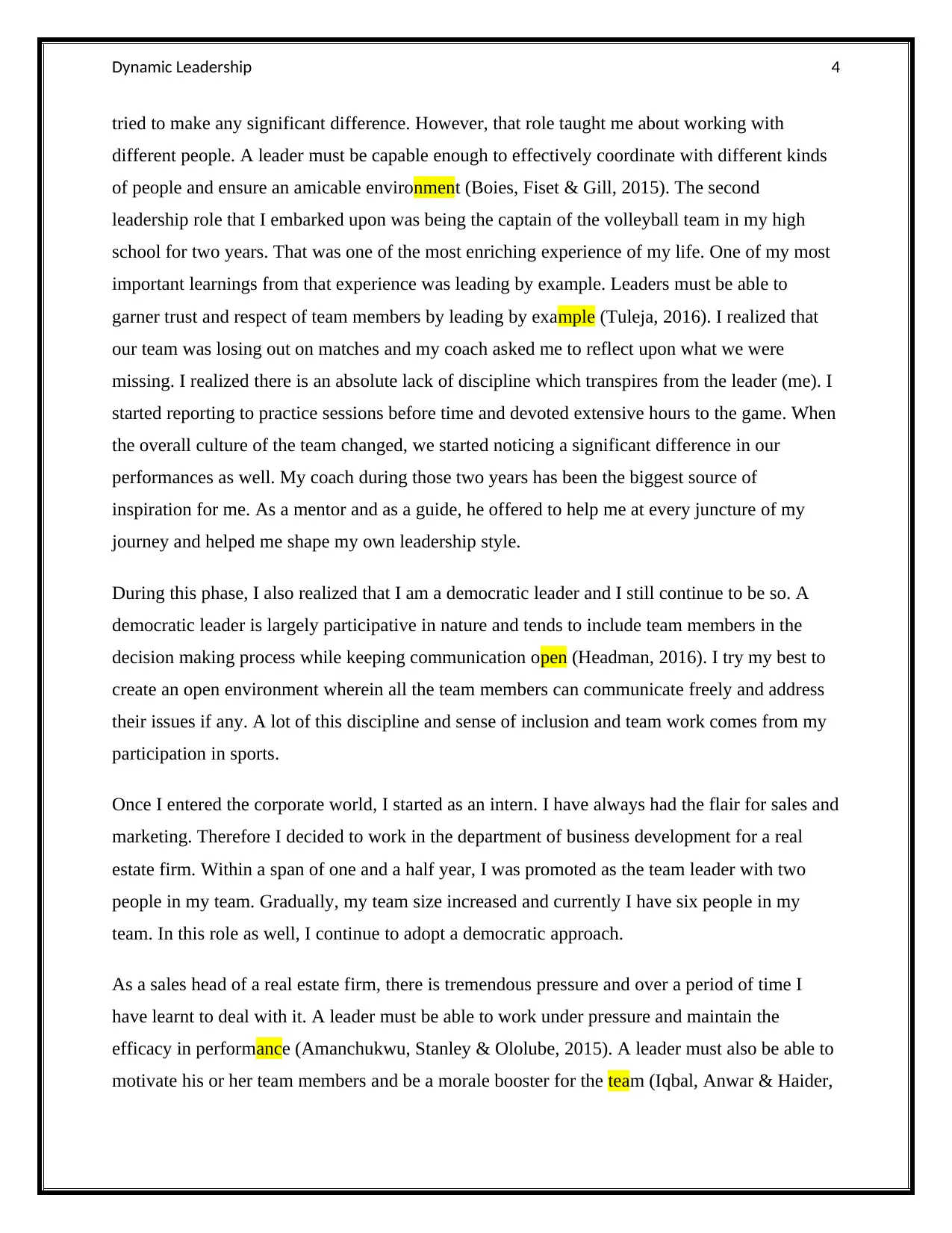
Dynamic Leadership 4
tried to make any significant difference. However, that role taught me about working with
different people. A leader must be capable enough to effectively coordinate with different kinds
of people and ensure an amicable environment (Boies, Fiset & Gill, 2015). The second
leadership role that I embarked upon was being the captain of the volleyball team in my high
school for two years. That was one of the most enriching experience of my life. One of my most
important learnings from that experience was leading by example. Leaders must be able to
garner trust and respect of team members by leading by example (Tuleja, 2016). I realized that
our team was losing out on matches and my coach asked me to reflect upon what we were
missing. I realized there is an absolute lack of discipline which transpires from the leader (me). I
started reporting to practice sessions before time and devoted extensive hours to the game. When
the overall culture of the team changed, we started noticing a significant difference in our
performances as well. My coach during those two years has been the biggest source of
inspiration for me. As a mentor and as a guide, he offered to help me at every juncture of my
journey and helped me shape my own leadership style.
During this phase, I also realized that I am a democratic leader and I still continue to be so. A
democratic leader is largely participative in nature and tends to include team members in the
decision making process while keeping communication open (Headman, 2016). I try my best to
create an open environment wherein all the team members can communicate freely and address
their issues if any. A lot of this discipline and sense of inclusion and team work comes from my
participation in sports.
Once I entered the corporate world, I started as an intern. I have always had the flair for sales and
marketing. Therefore I decided to work in the department of business development for a real
estate firm. Within a span of one and a half year, I was promoted as the team leader with two
people in my team. Gradually, my team size increased and currently I have six people in my
team. In this role as well, I continue to adopt a democratic approach.
As a sales head of a real estate firm, there is tremendous pressure and over a period of time I
have learnt to deal with it. A leader must be able to work under pressure and maintain the
efficacy in performance (Amanchukwu, Stanley & Ololube, 2015). A leader must also be able to
motivate his or her team members and be a morale booster for the team (Iqbal, Anwar & Haider,
tried to make any significant difference. However, that role taught me about working with
different people. A leader must be capable enough to effectively coordinate with different kinds
of people and ensure an amicable environment (Boies, Fiset & Gill, 2015). The second
leadership role that I embarked upon was being the captain of the volleyball team in my high
school for two years. That was one of the most enriching experience of my life. One of my most
important learnings from that experience was leading by example. Leaders must be able to
garner trust and respect of team members by leading by example (Tuleja, 2016). I realized that
our team was losing out on matches and my coach asked me to reflect upon what we were
missing. I realized there is an absolute lack of discipline which transpires from the leader (me). I
started reporting to practice sessions before time and devoted extensive hours to the game. When
the overall culture of the team changed, we started noticing a significant difference in our
performances as well. My coach during those two years has been the biggest source of
inspiration for me. As a mentor and as a guide, he offered to help me at every juncture of my
journey and helped me shape my own leadership style.
During this phase, I also realized that I am a democratic leader and I still continue to be so. A
democratic leader is largely participative in nature and tends to include team members in the
decision making process while keeping communication open (Headman, 2016). I try my best to
create an open environment wherein all the team members can communicate freely and address
their issues if any. A lot of this discipline and sense of inclusion and team work comes from my
participation in sports.
Once I entered the corporate world, I started as an intern. I have always had the flair for sales and
marketing. Therefore I decided to work in the department of business development for a real
estate firm. Within a span of one and a half year, I was promoted as the team leader with two
people in my team. Gradually, my team size increased and currently I have six people in my
team. In this role as well, I continue to adopt a democratic approach.
As a sales head of a real estate firm, there is tremendous pressure and over a period of time I
have learnt to deal with it. A leader must be able to work under pressure and maintain the
efficacy in performance (Amanchukwu, Stanley & Ololube, 2015). A leader must also be able to
motivate his or her team members and be a morale booster for the team (Iqbal, Anwar & Haider,
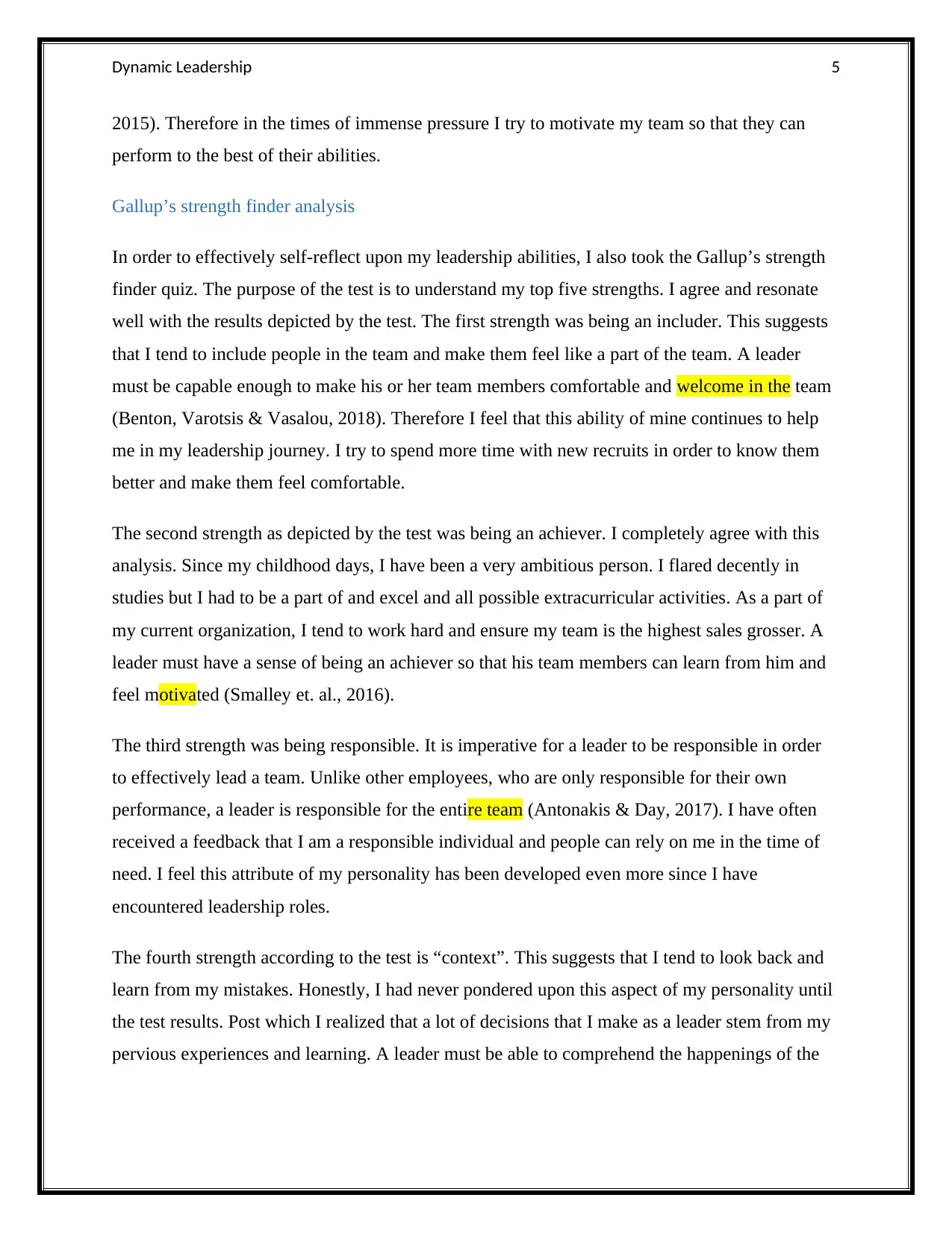
Dynamic Leadership 5
2015). Therefore in the times of immense pressure I try to motivate my team so that they can
perform to the best of their abilities.
Gallup’s strength finder analysis
In order to effectively self-reflect upon my leadership abilities, I also took the Gallup’s strength
finder quiz. The purpose of the test is to understand my top five strengths. I agree and resonate
well with the results depicted by the test. The first strength was being an includer. This suggests
that I tend to include people in the team and make them feel like a part of the team. A leader
must be capable enough to make his or her team members comfortable and welcome in the team
(Benton, Varotsis & Vasalou, 2018). Therefore I feel that this ability of mine continues to help
me in my leadership journey. I try to spend more time with new recruits in order to know them
better and make them feel comfortable.
The second strength as depicted by the test was being an achiever. I completely agree with this
analysis. Since my childhood days, I have been a very ambitious person. I flared decently in
studies but I had to be a part of and excel and all possible extracurricular activities. As a part of
my current organization, I tend to work hard and ensure my team is the highest sales grosser. A
leader must have a sense of being an achiever so that his team members can learn from him and
feel motivated (Smalley et. al., 2016).
The third strength was being responsible. It is imperative for a leader to be responsible in order
to effectively lead a team. Unlike other employees, who are only responsible for their own
performance, a leader is responsible for the entire team (Antonakis & Day, 2017). I have often
received a feedback that I am a responsible individual and people can rely on me in the time of
need. I feel this attribute of my personality has been developed even more since I have
encountered leadership roles.
The fourth strength according to the test is “context”. This suggests that I tend to look back and
learn from my mistakes. Honestly, I had never pondered upon this aspect of my personality until
the test results. Post which I realized that a lot of decisions that I make as a leader stem from my
pervious experiences and learning. A leader must be able to comprehend the happenings of the
2015). Therefore in the times of immense pressure I try to motivate my team so that they can
perform to the best of their abilities.
Gallup’s strength finder analysis
In order to effectively self-reflect upon my leadership abilities, I also took the Gallup’s strength
finder quiz. The purpose of the test is to understand my top five strengths. I agree and resonate
well with the results depicted by the test. The first strength was being an includer. This suggests
that I tend to include people in the team and make them feel like a part of the team. A leader
must be capable enough to make his or her team members comfortable and welcome in the team
(Benton, Varotsis & Vasalou, 2018). Therefore I feel that this ability of mine continues to help
me in my leadership journey. I try to spend more time with new recruits in order to know them
better and make them feel comfortable.
The second strength as depicted by the test was being an achiever. I completely agree with this
analysis. Since my childhood days, I have been a very ambitious person. I flared decently in
studies but I had to be a part of and excel and all possible extracurricular activities. As a part of
my current organization, I tend to work hard and ensure my team is the highest sales grosser. A
leader must have a sense of being an achiever so that his team members can learn from him and
feel motivated (Smalley et. al., 2016).
The third strength was being responsible. It is imperative for a leader to be responsible in order
to effectively lead a team. Unlike other employees, who are only responsible for their own
performance, a leader is responsible for the entire team (Antonakis & Day, 2017). I have often
received a feedback that I am a responsible individual and people can rely on me in the time of
need. I feel this attribute of my personality has been developed even more since I have
encountered leadership roles.
The fourth strength according to the test is “context”. This suggests that I tend to look back and
learn from my mistakes. Honestly, I had never pondered upon this aspect of my personality until
the test results. Post which I realized that a lot of decisions that I make as a leader stem from my
pervious experiences and learning. A leader must be able to comprehend the happenings of the
⊘ This is a preview!⊘
Do you want full access?
Subscribe today to unlock all pages.

Trusted by 1+ million students worldwide
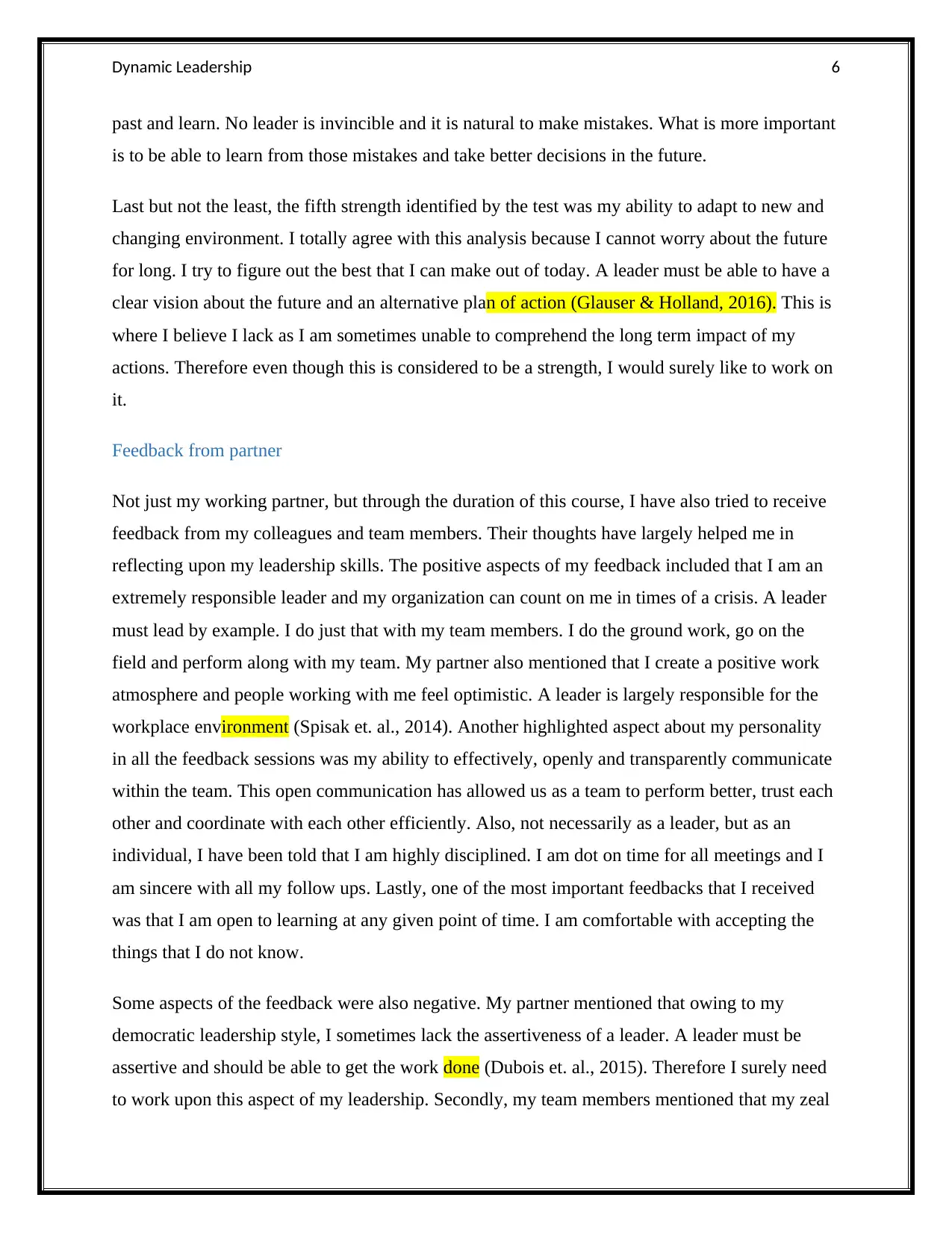
Dynamic Leadership 6
past and learn. No leader is invincible and it is natural to make mistakes. What is more important
is to be able to learn from those mistakes and take better decisions in the future.
Last but not the least, the fifth strength identified by the test was my ability to adapt to new and
changing environment. I totally agree with this analysis because I cannot worry about the future
for long. I try to figure out the best that I can make out of today. A leader must be able to have a
clear vision about the future and an alternative plan of action (Glauser & Holland, 2016). This is
where I believe I lack as I am sometimes unable to comprehend the long term impact of my
actions. Therefore even though this is considered to be a strength, I would surely like to work on
it.
Feedback from partner
Not just my working partner, but through the duration of this course, I have also tried to receive
feedback from my colleagues and team members. Their thoughts have largely helped me in
reflecting upon my leadership skills. The positive aspects of my feedback included that I am an
extremely responsible leader and my organization can count on me in times of a crisis. A leader
must lead by example. I do just that with my team members. I do the ground work, go on the
field and perform along with my team. My partner also mentioned that I create a positive work
atmosphere and people working with me feel optimistic. A leader is largely responsible for the
workplace environment (Spisak et. al., 2014). Another highlighted aspect about my personality
in all the feedback sessions was my ability to effectively, openly and transparently communicate
within the team. This open communication has allowed us as a team to perform better, trust each
other and coordinate with each other efficiently. Also, not necessarily as a leader, but as an
individual, I have been told that I am highly disciplined. I am dot on time for all meetings and I
am sincere with all my follow ups. Lastly, one of the most important feedbacks that I received
was that I am open to learning at any given point of time. I am comfortable with accepting the
things that I do not know.
Some aspects of the feedback were also negative. My partner mentioned that owing to my
democratic leadership style, I sometimes lack the assertiveness of a leader. A leader must be
assertive and should be able to get the work done (Dubois et. al., 2015). Therefore I surely need
to work upon this aspect of my leadership. Secondly, my team members mentioned that my zeal
past and learn. No leader is invincible and it is natural to make mistakes. What is more important
is to be able to learn from those mistakes and take better decisions in the future.
Last but not the least, the fifth strength identified by the test was my ability to adapt to new and
changing environment. I totally agree with this analysis because I cannot worry about the future
for long. I try to figure out the best that I can make out of today. A leader must be able to have a
clear vision about the future and an alternative plan of action (Glauser & Holland, 2016). This is
where I believe I lack as I am sometimes unable to comprehend the long term impact of my
actions. Therefore even though this is considered to be a strength, I would surely like to work on
it.
Feedback from partner
Not just my working partner, but through the duration of this course, I have also tried to receive
feedback from my colleagues and team members. Their thoughts have largely helped me in
reflecting upon my leadership skills. The positive aspects of my feedback included that I am an
extremely responsible leader and my organization can count on me in times of a crisis. A leader
must lead by example. I do just that with my team members. I do the ground work, go on the
field and perform along with my team. My partner also mentioned that I create a positive work
atmosphere and people working with me feel optimistic. A leader is largely responsible for the
workplace environment (Spisak et. al., 2014). Another highlighted aspect about my personality
in all the feedback sessions was my ability to effectively, openly and transparently communicate
within the team. This open communication has allowed us as a team to perform better, trust each
other and coordinate with each other efficiently. Also, not necessarily as a leader, but as an
individual, I have been told that I am highly disciplined. I am dot on time for all meetings and I
am sincere with all my follow ups. Lastly, one of the most important feedbacks that I received
was that I am open to learning at any given point of time. I am comfortable with accepting the
things that I do not know.
Some aspects of the feedback were also negative. My partner mentioned that owing to my
democratic leadership style, I sometimes lack the assertiveness of a leader. A leader must be
assertive and should be able to get the work done (Dubois et. al., 2015). Therefore I surely need
to work upon this aspect of my leadership. Secondly, my team members mentioned that my zeal
Paraphrase This Document
Need a fresh take? Get an instant paraphrase of this document with our AI Paraphraser
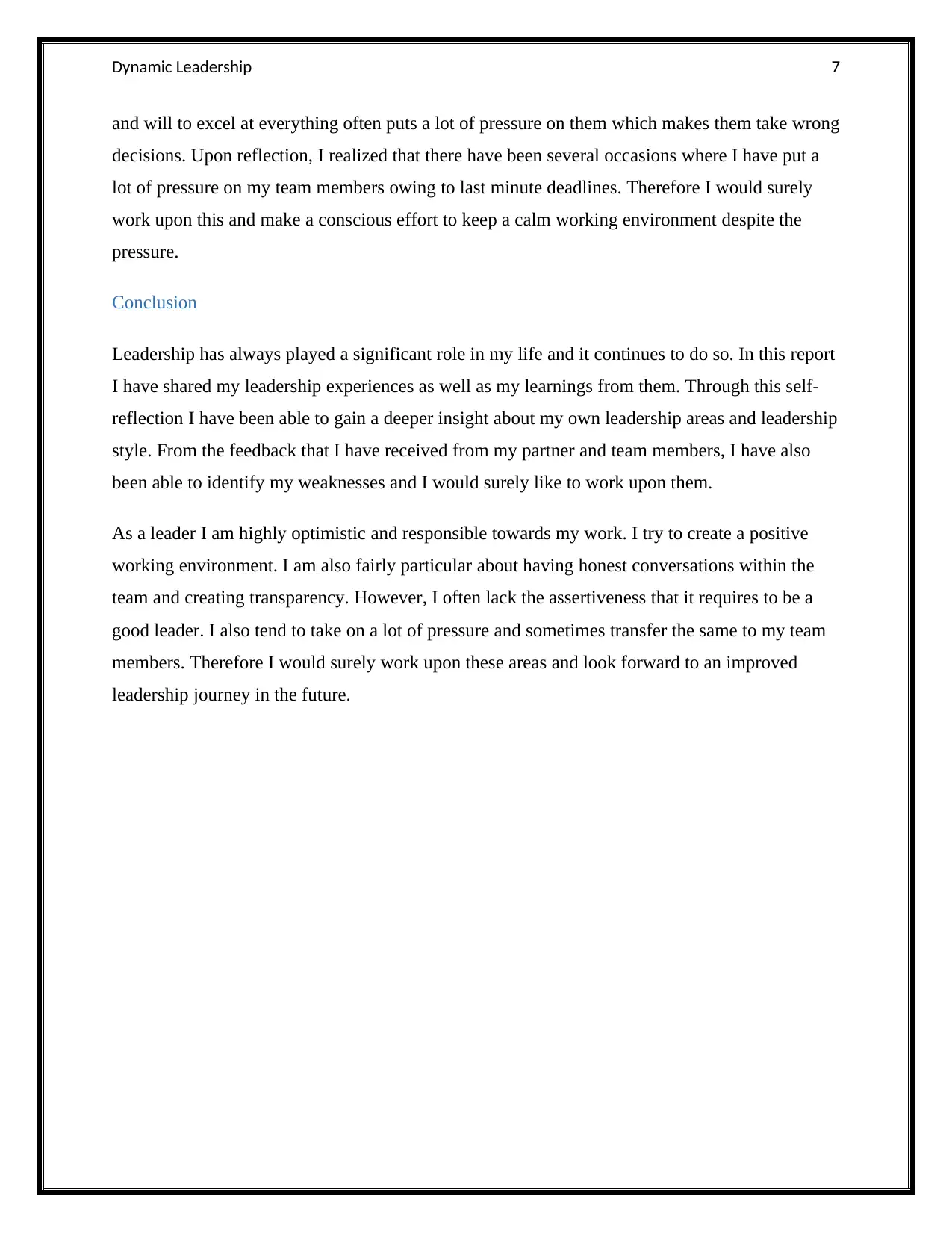
Dynamic Leadership 7
and will to excel at everything often puts a lot of pressure on them which makes them take wrong
decisions. Upon reflection, I realized that there have been several occasions where I have put a
lot of pressure on my team members owing to last minute deadlines. Therefore I would surely
work upon this and make a conscious effort to keep a calm working environment despite the
pressure.
Conclusion
Leadership has always played a significant role in my life and it continues to do so. In this report
I have shared my leadership experiences as well as my learnings from them. Through this self-
reflection I have been able to gain a deeper insight about my own leadership areas and leadership
style. From the feedback that I have received from my partner and team members, I have also
been able to identify my weaknesses and I would surely like to work upon them.
As a leader I am highly optimistic and responsible towards my work. I try to create a positive
working environment. I am also fairly particular about having honest conversations within the
team and creating transparency. However, I often lack the assertiveness that it requires to be a
good leader. I also tend to take on a lot of pressure and sometimes transfer the same to my team
members. Therefore I would surely work upon these areas and look forward to an improved
leadership journey in the future.
and will to excel at everything often puts a lot of pressure on them which makes them take wrong
decisions. Upon reflection, I realized that there have been several occasions where I have put a
lot of pressure on my team members owing to last minute deadlines. Therefore I would surely
work upon this and make a conscious effort to keep a calm working environment despite the
pressure.
Conclusion
Leadership has always played a significant role in my life and it continues to do so. In this report
I have shared my leadership experiences as well as my learnings from them. Through this self-
reflection I have been able to gain a deeper insight about my own leadership areas and leadership
style. From the feedback that I have received from my partner and team members, I have also
been able to identify my weaknesses and I would surely like to work upon them.
As a leader I am highly optimistic and responsible towards my work. I try to create a positive
working environment. I am also fairly particular about having honest conversations within the
team and creating transparency. However, I often lack the assertiveness that it requires to be a
good leader. I also tend to take on a lot of pressure and sometimes transfer the same to my team
members. Therefore I would surely work upon these areas and look forward to an improved
leadership journey in the future.
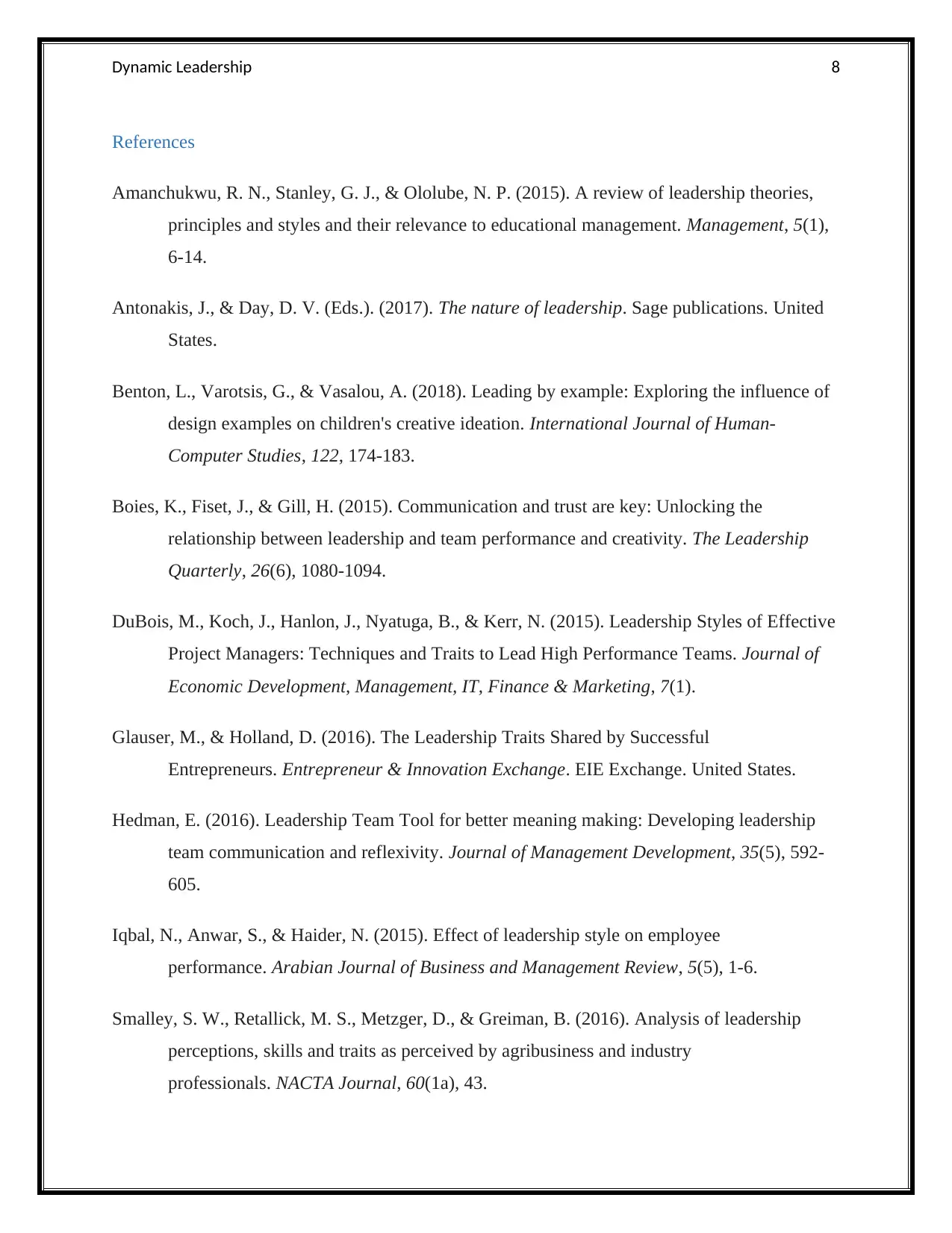
Dynamic Leadership 8
References
Amanchukwu, R. N., Stanley, G. J., & Ololube, N. P. (2015). A review of leadership theories,
principles and styles and their relevance to educational management. Management, 5(1),
6-14.
Antonakis, J., & Day, D. V. (Eds.). (2017). The nature of leadership. Sage publications. United
States.
Benton, L., Varotsis, G., & Vasalou, A. (2018). Leading by example: Exploring the influence of
design examples on children's creative ideation. International Journal of Human-
Computer Studies, 122, 174-183.
Boies, K., Fiset, J., & Gill, H. (2015). Communication and trust are key: Unlocking the
relationship between leadership and team performance and creativity. The Leadership
Quarterly, 26(6), 1080-1094.
DuBois, M., Koch, J., Hanlon, J., Nyatuga, B., & Kerr, N. (2015). Leadership Styles of Effective
Project Managers: Techniques and Traits to Lead High Performance Teams. Journal of
Economic Development, Management, IT, Finance & Marketing, 7(1).
Glauser, M., & Holland, D. (2016). The Leadership Traits Shared by Successful
Entrepreneurs. Entrepreneur & Innovation Exchange. EIE Exchange. United States.
Hedman, E. (2016). Leadership Team Tool for better meaning making: Developing leadership
team communication and reflexivity. Journal of Management Development, 35(5), 592-
605.
Iqbal, N., Anwar, S., & Haider, N. (2015). Effect of leadership style on employee
performance. Arabian Journal of Business and Management Review, 5(5), 1-6.
Smalley, S. W., Retallick, M. S., Metzger, D., & Greiman, B. (2016). Analysis of leadership
perceptions, skills and traits as perceived by agribusiness and industry
professionals. NACTA Journal, 60(1a), 43.
References
Amanchukwu, R. N., Stanley, G. J., & Ololube, N. P. (2015). A review of leadership theories,
principles and styles and their relevance to educational management. Management, 5(1),
6-14.
Antonakis, J., & Day, D. V. (Eds.). (2017). The nature of leadership. Sage publications. United
States.
Benton, L., Varotsis, G., & Vasalou, A. (2018). Leading by example: Exploring the influence of
design examples on children's creative ideation. International Journal of Human-
Computer Studies, 122, 174-183.
Boies, K., Fiset, J., & Gill, H. (2015). Communication and trust are key: Unlocking the
relationship between leadership and team performance and creativity. The Leadership
Quarterly, 26(6), 1080-1094.
DuBois, M., Koch, J., Hanlon, J., Nyatuga, B., & Kerr, N. (2015). Leadership Styles of Effective
Project Managers: Techniques and Traits to Lead High Performance Teams. Journal of
Economic Development, Management, IT, Finance & Marketing, 7(1).
Glauser, M., & Holland, D. (2016). The Leadership Traits Shared by Successful
Entrepreneurs. Entrepreneur & Innovation Exchange. EIE Exchange. United States.
Hedman, E. (2016). Leadership Team Tool for better meaning making: Developing leadership
team communication and reflexivity. Journal of Management Development, 35(5), 592-
605.
Iqbal, N., Anwar, S., & Haider, N. (2015). Effect of leadership style on employee
performance. Arabian Journal of Business and Management Review, 5(5), 1-6.
Smalley, S. W., Retallick, M. S., Metzger, D., & Greiman, B. (2016). Analysis of leadership
perceptions, skills and traits as perceived by agribusiness and industry
professionals. NACTA Journal, 60(1a), 43.
⊘ This is a preview!⊘
Do you want full access?
Subscribe today to unlock all pages.

Trusted by 1+ million students worldwide
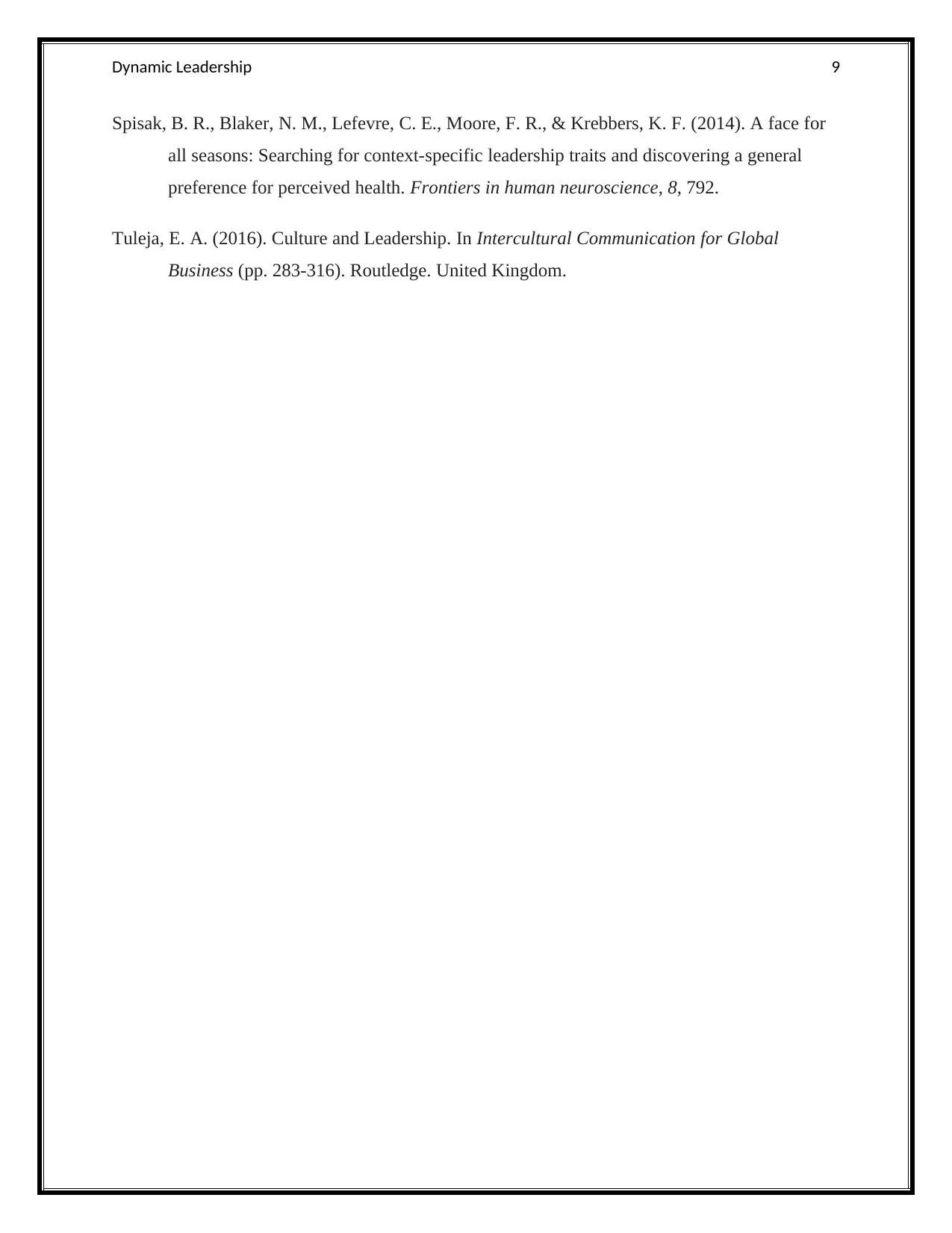
Dynamic Leadership 9
Spisak, B. R., Blaker, N. M., Lefevre, C. E., Moore, F. R., & Krebbers, K. F. (2014). A face for
all seasons: Searching for context-specific leadership traits and discovering a general
preference for perceived health. Frontiers in human neuroscience, 8, 792.
Tuleja, E. A. (2016). Culture and Leadership. In Intercultural Communication for Global
Business (pp. 283-316). Routledge. United Kingdom.
Spisak, B. R., Blaker, N. M., Lefevre, C. E., Moore, F. R., & Krebbers, K. F. (2014). A face for
all seasons: Searching for context-specific leadership traits and discovering a general
preference for perceived health. Frontiers in human neuroscience, 8, 792.
Tuleja, E. A. (2016). Culture and Leadership. In Intercultural Communication for Global
Business (pp. 283-316). Routledge. United Kingdom.
1 out of 10
Related Documents
Your All-in-One AI-Powered Toolkit for Academic Success.
+13062052269
info@desklib.com
Available 24*7 on WhatsApp / Email
![[object Object]](/_next/static/media/star-bottom.7253800d.svg)
Unlock your academic potential
Copyright © 2020–2025 A2Z Services. All Rights Reserved. Developed and managed by ZUCOL.




